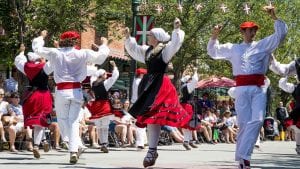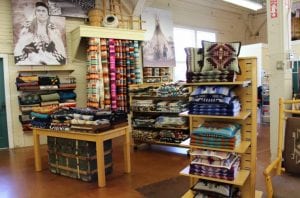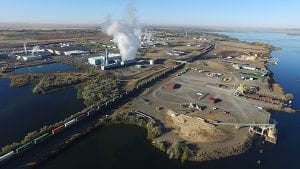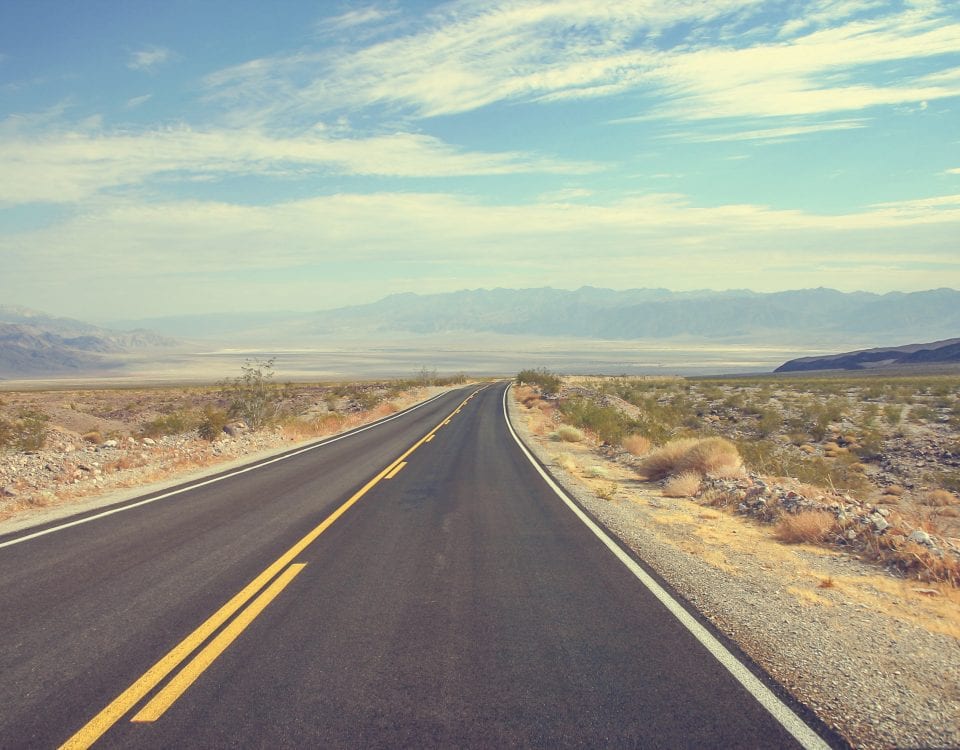
Day 58: Volcanoes and Skyjackers on the Way to Portland
May 16, 2021
Day 56: Salt, Railroads and Bridge Jumps
May 14, 2021Most recently updated on February 27, 2024
Originally posted on May 15, 2021
A new state, a new time zone and the place where lumberjack-type shirts were invented.
All ahead of us on our journey today on Day 57.
We begin by departing out of Twin Falls in southern Idaho in a northeasterly direction on Interstate 84, a freeway we will be driving the entire day.
It’s a two-hour drive from here to Boise, the state capital and most populous city in Idaho with more than 230,000 residents.
Boise has a strong lumber trade, but it also has some high-tech industry, an active community of immigrants from Spain and a memorial dedicated to human rights.
The Northern Shoshone and Bannock were among the tribes that lived in the area for thousands of years.
French fur trappers were in the region in the early 1800s. In fact, the name of the town apparently came from “bois,” the French word for “wooded” due to all the forests in the region, which sits at an elevation of 2,730 feet.
In 1834, the Hudson Bay Company established a trading post for wagon trains traveling the Oregon Trail in an area near Boise. Settlers began arriving after gold was discovered in 1862. Fort Boise was established in 1863 by the U.S. Army. Boise was incorporated as a city in 1864 and the Idaho Penitentiary was built in 1870.

The Basque community celebrates its heritage and culture with the annual San Inazio Festival in Boise, Idaho, every September. Photo by the Idaho Statesman.
After the gold rush declined, Boise struggled due to its isolated location. Some citizens developed the Boise Irrigation Project in 1902 so their land could be farmed. They also created shady streets near the Boise River. Agriculture and lumber became strong early industries.
In 1912, the Morrison-Knudsen construction company was formed. The company worked on the Hoover Dam, among other projects.
Boise began to develop more after the State Capitol building was finished in 1920 and the Union Pacific Railroad depot was built in 1925. Dams were also constructed to provide water and hydroelectric power.
During World War Two, the Gowen Field flight and training base was operating. The field is now home to the Idaho Air National Guard and the 124th Fighter Wing.
Boise Cascade began business operations with the city as its headquarters in 1957. It was formed from the merger of Cascade Lumber Company of Yakima, Washington, and Boise Payette Lumber Company. Boise Cascade purchased OfficeMax in 2018 and underwent a major corporate reshuffling in 2019. Its paper products company’s headquarters remain in Boise. The company manufactures plywood as well as producing other wood products, lumber and particle board. It has 7,300 employees in North America and annual revenue of nearly $7 billion.
Idaho Pacific Lumber has its headquarters in nearby Meridian. The employee-owned enterprise started operations in 1979 and caters to the construction industry. It has 100 employees and generates about $20 million in annual sales.
Albertson’s also has its headquarters in Boise. Joe Albertson opened his first store here in 1939 with $5,000 of his savings and $7,500 he borrowed from his wife’s aunt. Within two years, he had opened two other stores and the company was generating $1 million in annual sales. Today, Albertson’s has stores in 35 states with about 290,000 employees. The original store at 16th and State streets is still open. The world’s largest Albertson’s is in nearby Treasure Valley. The 100,000-square-foot store opened in 2019.
High tech and electronics have boosted the economy since the 1990s.
Hewlett Packard has a welcome center in town where the public can view future products in the design and testing phases.
Micron Technology has headquarters here. The company employs a total of 43,000 people worldwide.
Micron Technology is also getting into the chip manufacturing industry. The company has begun construction on a $15 billion memory chip production facility as part of its Boise campus. It’s expected to open in 2025 and eventually employ 2,000 people. The complex is receiving funding from the chip manufacturing bill signed by President Joe Biden in August 2022.
The State Capitol is also a major employer. Construction began on the building in 1905 and was finished in 1920. The dome is 208 feet high with 190,000 square feet of usable space. From the first floor looking up at the dome you can see 13 stars for the original colonies and another 43 stars representing Idaho being the 43rd state. There is a scale replica of the Liberty Bell out front without the signature crack. It’s the only capital building heated by geothermal water.
In the mid-1950s, Boise was the center of a hysteria involving homosexuality. It was part of the so-called “Lavender Scare” era that swept the country from the late 1940s into the early 1960s where gay employees in federal government were fired or forced to quit once their sexuality was discovered. The purges resulted in gay people leaving rural areas and small towns and forming their own undercover communities in other places.

The Idaho Anne Frank Human Rights Memorial in Boise. Photo by the Idaho Anne Frank Human Rights Memorial.
In Boise, the scare started with the arrest of three men on Halloween night in 1955. Authorities said their investigation was to protect children, but the men were arrested for having sex with other men. The investigation ended in January 1957 with 1,500 people questioned, 16 men facing charges and nine men convicted and receiving sentences from probation to life in prison.
All this happened amid inflammatory newspaper editorials and proclamations that homosexuality was a mental illness that needed treatment as well as a criminal act that required punishment.
“The Boys of Boise” became a book in 1965 and a documentary called “That Fall of ’55” was released in 2006.
In recent decades, Boise has shown more tolerance and a little more diversity.
The city has 16,000 Basque residents, one of the largest Basque communities in the United States. Many of the immigrants fled Spain during President Francisco Franco’s rule from 1939 to 1974. There are now second and third generations living in Boise.
The San Inazio Basque festival is held every summer here. Jaialdi, a Basque festival held every 5 years and attended by people from around the world, will return to Boise in 2025.
There is a Basque Block downtown with a museum, restaurant, market and cultural center that opened in 2005. The Basque Museum and Cultural Center is the only Basque museum in the United States.
Boise is also home to the Idaho Anne Frank Human Rights Memorial. The park is slightly less than 1 acre in size and is dedicated to human rights, diversity and human dignity. The monument has a 180-foot “quote wall” with sayings from famous people. Other items include a bronze diary, an Anne Frank statue and a book case.
All Over Oregon
We continue northbound out of Boise on Interstate 84 and in about an hour we cross the Snake River once again and enter into Oregon, the 47th state on our adventure.
The Beaver State is the nation’s 9th largest at slightly under 100,000 square miles with a mean elevation of 3,300 feet, the 9th highest. As we will see over the next couple days, it’s a state where the geography changes dramatically as you move away from the Pacific Coast. High desert-like terrain encompasses much of the eastern half while rain-soaked land is common in the western half.
The state also has a diverse geology from volcanoes to waterways to forests to high desert to shrubland. Crater Lake is the deepest lake in the United States at 1,943 feet and Mount Hood is an active volcano. In addition, the state contains the largest organism in the world with fungus that covers 2,200 acres in the Malheur National Forest.

Most of the residents here live in the center of the state. Overall, Oregon is 27th in population with more than 4 million people. The ethnicity is listed as 73 percent white, 14 percent Hispanic or Latino, 5 percent Asian and 2 percent Black.
The first European explorers came from Spain in 1543. Sir Frances Drake and Captain Cook may also have explored the region. Fur traders from Canada, England and Russia arrived in the 1700s and early 1800s. Explorers Meriwether Lewis and William Clark ended their westward expedition in Oregon in November 1805. During the 1800s, many settlers arrived via the Oregon Trail.
In the 1840s, Black exclusion acts were adopted to prohibit African-Americans from settling. Although the state banned slavery in 1843, a number of scholars say racism is deeply rooted in the state’s history. A 2016 article in The Atlantic detailed the discriminatory attitudes toward people of color in the past as well as the present, including the racial intolerance that can be found in the generally liberal city of Portland.
The Oregon Territory was formed in 1848. The railroads arrived in the 1880s and expanded the state’s lumber, wheat and other agricultural industries.
Between 1933 and 1937, the Bonneville Dam was built on the Columbia River, increasing development. The state’s economy suffered during the 1980s when the timber market crashed and business leaders have since built a more diverse economy.
The main industries now are agriculture, fishing (especially salmon) and hydroelectric power. Oregon is the leading producer of hazelnuts, making up 99 percent of the U.S. product. Oregon is also the top state in Christmas tree production. It’s fourth in pear production and is also one of top blueberry growing states.
The timber industry used to be dominant but environmental laws on federal land significantly reduced the industry in the 1980s. Technology with the formation of Silicon Forest in the 1970s has gained a foothold.
In addition, Nike has its world headquarters in Beaverton, west of Portland, and Harry and David is headquartered in Medford.
Oregon is now a socially progressive state.
It has allowed physician-assisted suicide under its Death With Dignity Act since 1997. Same-sex marriage has been recognized since 2013.
Medicinal marijuana has been legal here since 1998. Recreation marijuana for people over 21 was approved in 2014. In fact, the Oregon may have too much of a good thing here. In 2019, state leaders approved two new laws to deal with an oversupply of cannabis. One of the laws tightened the licensing requirements for places that sell the product. The other allows the governor to enter into agreement with other states to sell excess marijuana. Still, it was reported in April 2023 that cannabis prices were slumping because supply is still higher than demand. In October 2023, several Oregon cannabis industry groups merged in an effort to better oversee the state’s $1 billion cannabis industry. Cannabis sales in Oregon in 2023 declined 4 percent from the previous year and prices remain stagnant.
Finally, in June 2023, Oregon lawmakers approved a law that ended the state’s ban on self-service gasoline pumps. That leaves New Jersey has the only state that still requires attendants to pump gas.
Shirts and Ships
We continue to power northbound on I-84. About an hour and a half after crossing the border, we cruise over the 45th parallel, that imaginary line halfway between the equator and the North Pole, for a fifth time during our travels.
About an hour after that milestone, we pull into Pendleton, a community in eastern Oregon that is tied to the shirt that carries its name and a popular 1960s rock band that wore them before they were famous.
The town boasts a population of nearly 17,000 people, about 1,600 of whom reside at the Eastern Oregon Correctional Institute. The town’s population is 78 percent white and 12 percent Hispanic or Latino.

The Pendleton Woolen Mills in eastern Oregon manufactured Native American blankets as well as shirts. Photo by Wander With Wonder.
The Confederated Tribes of the Umatilla Indian Reservation have property nearby with a resort casino and a cultural center. The reservation was the result of an 1855 treaty with government officials.
A commercial center began to develop here in 1851 when Dr. William C. McKay set up a trading post. In 1865, a post office opened. In 1868, the settlement was named for George H. Pendleton, who was the Democratic vice presidential candidate in 1864.
The city was incorporated in 1880. The town had a vibrant Chinese community from immigrants who worked on the Transcontinental Railroad. Their neighborhood featured underground tunnels.
The railroad arrived in 1889 and the city developed into a railhead hub that was a shipping point for the wool industry from the area’s many sheep ranches.
Pendleton’s airport was expanded during World War Two. Jimmy Doolittle and his crew trained there before their bombing mission over Japan in 1942.
The big industry in town was the Pendleton Woolen Mills. It was established by Thomas Lister Kay, an English immigrant and weaver by trade who came to Oregon in 1863. Kay established a mill in Salem, Oregon, in 1889. Pendleton Woolen Mills was built in 1893.
In 1908, Kay’s daughter, Fannie Bishop, and her husband purchased the now defunct wool factory. At that time, eastern Oregon had 3 million sheep and there was also the railroad in Pendleton as well as the nearby Columbia River. So, the family built a new plant with help from $30,000 in city bonds. The family’s three sons oversaw the operation.
The Pendleton company revived the manufacture of Native American blankets (with square corners rather than round). In 1912, they opened another woolen mill in Washougal, Washington, for production of woolen fabrics for suits and other clothes. In 1924, the company began producing woolen sports shirts. Before that, woolen shirts were thought of as drab work attire. In 1929, a full line of woolen sportswear came out.
During World War Two, Pendleton manufactured blankets, uniforms and clothing for the U.S. military. In 1949, it began marketing a women’s sportswear line. A 49er jacket as well as a reversible pleated skirt were popular.
In 1972, the company began producing lighter sportswear for summer. In the 1980s, it began selling items in specialty stores and select department stores. It then began a mail order as well as an online business.
The Pendleton company is still owned by Bishop family. Its headquarters is now in Portland, Oregon. The company operates more than 30 stores. The Salem mill operated until 1962. It’s now part of the Willamette Heritage Center.
The Pendleton does own a piece of rock ‘n’ roll history. In the early 1960s, an upstart Los Angeles area rock band formed by three brothers and a cousin took the name The Pendletones because they wore pendleton shirts. The band released a single in 1961 called “Surfin’” that gained some modest attention. Shortly afterward, the group members exchanged their Pendleton shirts for more casual attire and changed their name to The Beach Boys. Their hit album “Surfin’ Safari” was released the following year.
The city is home to the Pendleton Round Up. The annual rodeo is held during September. It started in 1910 with help from the Bishop family. About 50,000 people attend in a typical year. There are 10 events during the weeklong event. The Main Street Cowboys, a group formed in 1950, helps with the planning of the round-up.
————————————————
Out of Pendleton, Interstate 84 bends to the west and in 45 minutes takes us to the Columbia River and our final destination on Day 57.
Boardman is a town of 4,000 people that has the second largest port in Oregon and a couple of high-powered electricity generating facilities.
The region was homesteaded in 1903 by Samuel Herbert Boardman, who was the first superintendent of the Oregon State Parks System. Boardman tried for 13 years to bring irrigation water to the town. He planted 5,000 trees along the Columbia River while he waited.
The first permanent settler arrived in 1915. The town was platted in 1916 and named after Boardman. In 1918, the West Extension Irrigation Canal was completed. The city was incorporated in 1927 and Union Pacific established a railroad station.

The Port of Morrow in Boardman, Oregon. Photo by the Port of Morrow.
In 1940, the Umatilla Army Depot was opened on 20,000 acres east of town. From 1962 to 1969, the facility received chemical weapons. It once stored 12 percent of the nation’s chemical weapons supply. From 1996 to 2012 under the name of Umatilla Chemical Agent Disposal Facility, workers there destroyed those weapons. The site was closed in 2012.
In 1952, Boardman was moved a half-mile to accommodate U.S. Highway 30. In 1965, the town was moved another quarter-mile when the John Day Dam was built. Lake Umatilla now covers much of the original town.
In 1963, the state leased 94,000 acres of land to Boeing for aerospace development and testing. The original plans for a rocket test site never materialized. In 1974, the company turned part of the property into a farming and ranching operating, irrigating 63,000 acres. Boeing has sublet portions of the acreage to other organizations over the years. Its 77-year lease doesn’t expire until 2040.
The main facility in Boardman is the Port of Morrow, the second largest port in Oregon at 12,000 acres. The port has four industrial parks and a major grain barge terminal. Amazon has two data centers at the port. The Internet giant has seven data centers now in northeastern Oregon.
There are also two Portland General Electric Company natural gas-fired power plants at the port. The utility closed its coal-fired power plant on the property in 2020. It was the last coal plant in Oregon.
In 2014, the Oregon Department of State Lands rejected a plan to export 8 million tons of coal from Wyoming and Montana through the Port of Morrow to Asia. The project would have involved two ports, 22 trains a week and 128 ships a year. The state ruling was upheld by an administrative law judge in 2016.
Alto Columbia operates a biofuel plant in Boardman that produces ethanol, grains and corn oil. Most of it is shipped by barge along the Columbia River to the Portland area. The plant, which opened in 2007, is part of Oregon’s Clean Fuels Program.
Agriculture is still a main industry, producing grain, hay, potatoes, mint and onions. Lamb Weston produces potato products at its facilities here. Oregon Potato Company also has a plant near town as does Boardman Foods, which specializes in onion products.
With that, we’ll call it a day.
Tomorrow, we head to the Pacific Northwest powerhouse of Portland, Oregon, with detours to Mount St. Helens, the bridge where a famous trail hike ended and the town where a notorious skyjacker would have landed if he indeed did survive his parachute jump.


